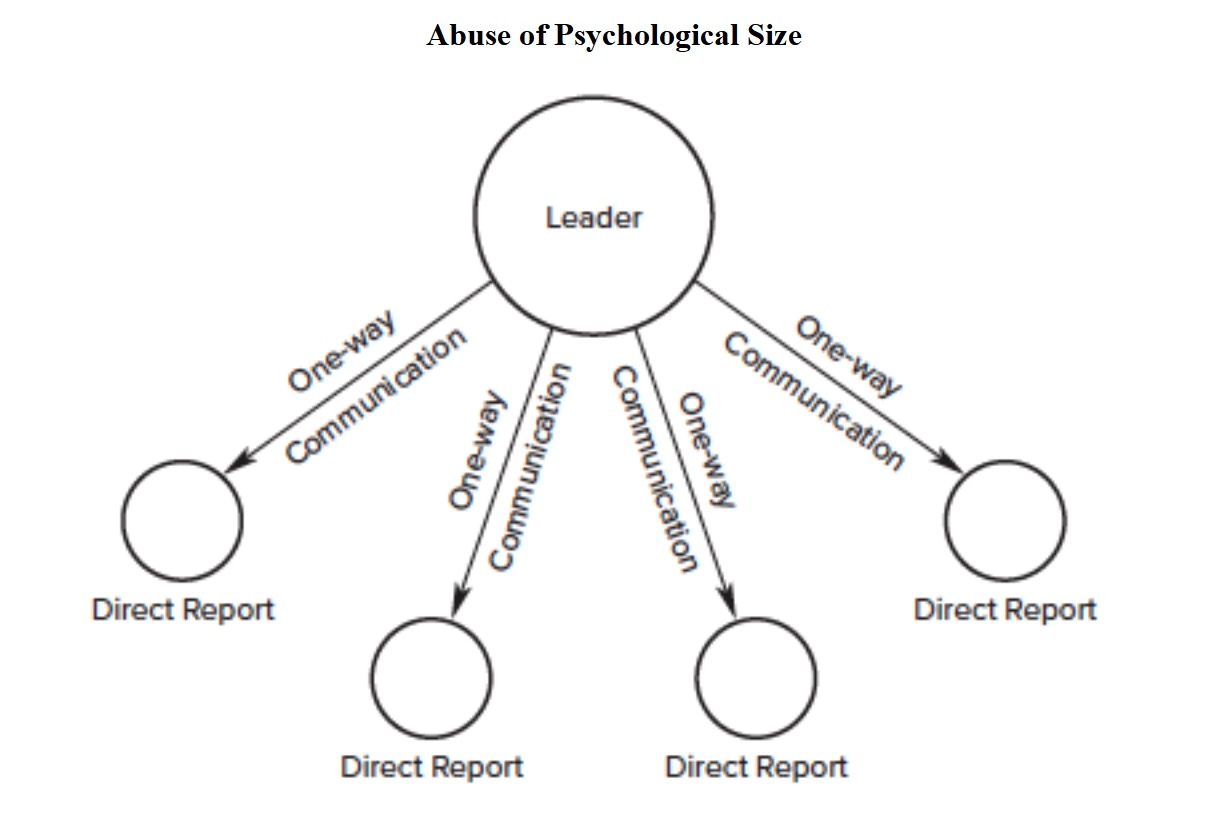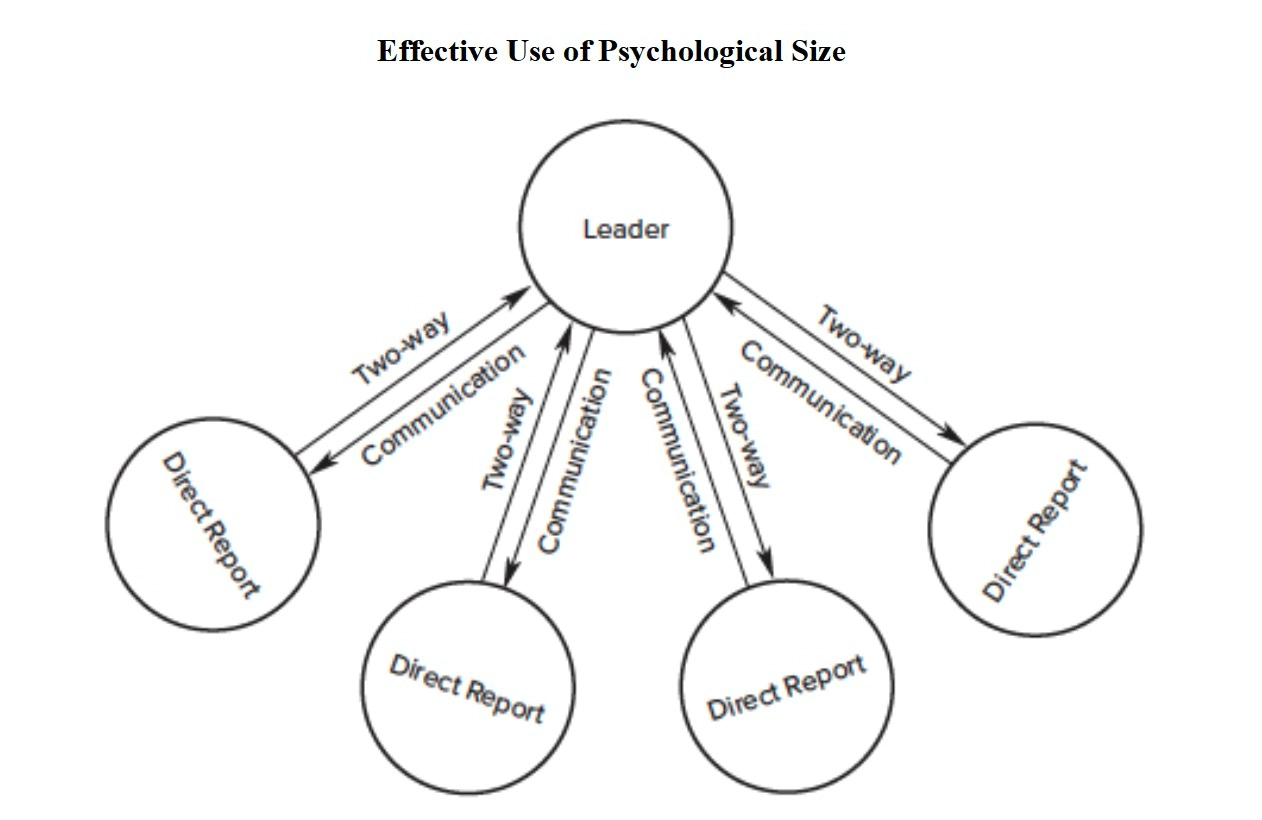Leadership, Psychological Size, and Two-Way Communication
The concept of psychological size has special relevance for people in authority positions.

The concept of psychological size has special relevance for people in authority positions. The individual who determines careers, decides wages, and makes job assignments has considerable power over others, and this power can influence the communication process. If psychological size is abused, communications breakdown, poor human relations result, and job performance suffers.1
Employees are in a weaker position, dependent to some degree on the authority figure to protect them and watch out for their well-being. Some will deny this observation, but one has only to observe the typical work environment to see how differences in psychological size can affect relationships and determine the way things are done. Deference and paternalism are not uncommon.2
People in positions of authority are often surprised to discover that others may fear their power and inhibit behavior accordingly. A graphic representation of a leader with big psychological size and the one-way communication that can result is presented in the following figure.

One-way communication presents three problems:
- People may be reluctant to say or do anything that might offend the powerful figure. According to George Reedy in The Twilight of the Presidency, even people who had enjoyed two-way communication with Lyndon Johnson when he was in the Senate began to censure their behavior once he assumed the presidency.3
- People may become dependent on the leader to make all the decisions. Unwilling to risk making a mistake and being criticized, people may fail to take initiative. The leader must then solve all the problems and make all the decisions. Dependency on the leader underuses direct reports and overburdens the leader.
- People may become resentful of the leader. The leader is seen as autocratic and arrogant, and this perception may cause anger, hostility, and even rebellion. Consider the case of the infamous Captain Queeg in the film classic The Caine Mutiny. The captain's abusive behavior eventually led to tragedy for everyone.
How can leaders avoid the abuse of psychological size and develop the two-way communication that is necessary for both employee morale and job performance? First, they must recognize the factors that contribute to psychological bigness:
- High-status position.
- Use of terminal statements so that no disagreement is possible.
- Formal, distant manner.
- Know-it-all, superior attitude.
- Commanding physical appearance.
- Power to make decisions.
- Use of sarcasm and ridicule.
- Job competence.
- Cruel and punishing remarks.
- Ability to express oneself.
- Interrupting and shouting at others.
- Public criticism.
Some of the items on this list are distinctly positive. For example, job competence and the ability to express oneself are desirable traits. Additionally, some of the factors causing psychological bigness are attributes of the person or the office, and it may be difficult or undesirable to change them. For example, neither a leader's commanding physical appearance nor the power to make decisions should be changed. Similarly, the status of the position is most likely an unchangeable factor, such as a father in the family.
The seven remaining factors of psychological bigness on this list, however, serve no purpose except to alienate people and result in one-way communication:
- Use of sarcasm and ridicule.
- Use of terminal statements so that no disagreement is possible.
- Formal, distant manner.
- Cruel and punishing remarks.
- Know-it-all, superior attitude.
- Interrupting and shouting at others.
- Public criticism.
As a rule, leaders should avoid behavior that demeans or intimidates another person. The solution is to equalize psychological size. A picture of the effective use of psychological size and good two-way communication is presented in the figure below.

Many leaders mistakenly think that the best way to equalize psychological size is to reduce their own size. In doing so, however, they may reduce their size so much that respect is lost and cannot be regained. Few individuals have the ability to go from large psychological size to small psychological size and back again without losing effectiveness. Therefore, the most effective approach is not for leaders to reduce their own psychological size but to raise the size of others.
The effective leader is a very big circle with a very big reputation, but this leader never gets in the way of the growth of others. The best way to raise psychological size is to show genuine interest in people. Through attention to others and sincere listening, the leader shows that others are important. A proven technique is to give people a project, some work to "grow into." This approach builds pride and commitment, and it increases the productivity of the group as a whole.
Leaders should keep in mind four points in developing two-way communication. First, be approachable. Second, model an honest and open style of communication. Be direct and sincere in speaking. Third, be patient. It takes time for trust to develop between people. Fourth, make a sincere effort to draw people out without constantly evaluating their remarks. This will be seen as a demonstration of respect. The following guidelines can help accomplish this goal:4
- Stop talking. You cannot listen to others if you are talking. Shakespeare wrote, "Give every man thine ear, but few thy voice."5 We each have two ears and one mouth, and we should use these in proportion.
- Put the person at ease. Help the other person feel free to talk. Provide a supportive environment or atmosphere. Sit or stand in a relaxed manner.
- Show the person that you want to listen. Look and act interested. Don't read your e-mails or text messages while the other person is talking. Maintain eye contact.
- Remove distractions. Don't doodle on, tap, or shuffle papers. Shut down the computer. Hold telephone calls. Will it be quieter if you close the door?
- Empathize with the person. Try to put yourself in the other person's place to understand their point of view.
- Be patient. Allow time. Don't interrupt. Don't walk toward the door or walk away while the other person is talking. Some people take longer than others to make a point.
- Hold your temper. An emotional person may misinterpret a message or may say something unintended. If you are angry, cool off before responding. Take a walk, or try counting to 10.
- Go easy on argument and criticism. Being judgmental puts others on the defensive and may result in a blowup, or it may cause the person to shut down. Listen to understand, rather than to make judgments.
- Ask questions. This response encourages the person and shows you are listening. It also helps develop additional points. Few actions demonstrate respect as much as asking others for their opinion.
- Encourage clarification. When the person touches on a point you want to know more about, simply repeat the statement as a question. This technique will allow clarification and elaboration.
- Stop talking. This is the first and last point, because all others depend on it. You cannot do a good job of listening while you are talking. As Shakespeare wrote, "Give thy thoughts no tongue."6
Philosopher Tom Morris, author of If Aristotle Ran General Motors, reminds leaders: When you're in a position of power over others, your words get amplified far more than you may realize. A whisper can sound like a shout. There's a megaphone at work, and you're not on the end where you hear the extra volume.7
Overall, a leader’s use of psychological bigness and overbearance is effective for only a short period of time. After a while, dissatisfaction causes employees to rebel or escape. The simple solution is to speak less and listen more, thereby showing respect for others. Effective leaders at all levels of authority understand this human relations principle.
For related reading, see:
Are You Listening? by Ralph Nichols
Emotional Intelligence by Daniel Goleman
The Servant by James Hunter
1. H. Mintzberg, Power in and around Organizations (Englewood Cliffs, NJ: Prentice-Hall, 1983); J. William Pfeiffer and J. E. Jones, Structured Experiences (University Associates Publishers, 1974).
2. H. Levinson, Executive (Cambridge: Harvard University Press, 1981), pp 44-46.
3. G. Reedy, The Twilight of the Presidency (New York: World, 1970), pp. 11-15, 76-83.
4. A. Mehrabian, Nonverbal Communication (New York: Aldine Transactions, 2007); and J. Newstrom, Organizational Behavior, 14th ed. (New York: McGraw-Hill/Irwin, 2014).
5. C. DeLoach, The Quotable Shakespeare (Jefferson, NC: McFarland, 1988), pp. 1, 3, 68.
6. C. DeLoach, The Quotable Shakespeare, pp. 1, 3, 59.
7. T. Morris, If Aristotle Ran General Motors (New York: Henry Holt & Company, (1997)



